The Power of Nonverbal Communication in Public Speaking
- Speaking tips , Presentations , Psychology
Public speaking is more than just the words you say. It’s about how you say them, how you connect with your audience, and the messages you convey through your nonverbal communication.
In this comprehensive guide, we will explore the significance of nonverbal communication , the key elements that make up nonverbal cues, and practical strategies to harness this power to become a more effective and persuasive public speaker .

Table of Contents

The Silent Language
Nonverbal communication, often referred to as “the silent language,” encompasses all the ways we convey information without using words. It’s a potent form of communication because it operates on a subconscious level, influencing how our message is received and interpreted by our audience.
This encompasses a wide range of cues, including:
- Body Language : Your posture, gestures and physical movements.
- Eye Contact : The way you make and maintain eye contact with your audience.
- Proximity : How close or far you are from your audience or other individuals on the stage.
- Appearance : Your clothing, grooming, and overall appearance, which can influence your audience’s perception.
- Use of Space : How you move around the stage or speaking area, including gestures and body positioning. This even includes how you use the frame on camera if you’re speaking online.
- Silence : The pauses and moments of silence in your speech, which can convey meaning and emphasis.
- Facial Expressions: We often have a poker face which does’t do much to enhance the message we’re aiming to convey. Facial expressions that go with the message can amplify your impact.

Photo by Natasha Hall on Unsplash
The Impact of Nonverbal Communication
Nonverbal communication plays a critical role in public speaking for several reasons:
1. Conveys Emotion and Authenticity
Your facial expressions, gestures, and tone of voice allow you to express emotions authentically. When your nonverbal cues align with your message, it adds depth and authenticity to your talk. For example, a smile can convey warmth and approachability, while a furrowed brow may signal concern or seriousness.
2. Enhances Message Clarity
Nonverbal cues can clarify your message, making it easier for your audience to understand and remember. Hand gestures can illustrate key points, and vocal variations can emphasize critical information. These cues act as signposts that guide your audience through your speech.
Pro-tip: if you over-do hand gestures or use repetitive ones, they can be distracting and damage your impact instead of enhancing it.
3. Builds Connection
Effective nonverbal communication helps you establish a strong connection with your audience. Maintaining eye contact, for instance, fosters a sense of engagement and rapport. A speaker who appears confident and approachable through their body language is more likely to connect with the audience .

4. Captures Attention
Engaging nonverbal cues can capture and maintain your audience’s attention. Movement, gestures, and vocal changes can add dynamism to your speech, preventing your audience from becoming disengaged or bored.
In a world where we’re constantly bombarded with notifications and urgent tasks, gaining attention is the real currency.
5. Demonstrates Confidence
Confidence is a quality that every public speaker should exude. Nonverbal cues such as upright posture, steady eye contact, and controlled body movements convey confidence to your audience. When you appear confident, your audience is more likely to trust and respect your message.
Key Elements of Effective Nonverbal Communication
To harness the power of nonverbal communication in public speaking, it’s essential to focus on specific elements and techniques. Let’s explore these key elements:
1. Body Language
Our posture, movements, and gestures are like an open book, revealing our emotions, confidence level, and authenticity. Here’s how body language can enhance or hinder your public speaking:
Posture : Stand or sit upright with your shoulders back. Good posture exudes confidence and presence. Conversely, slouching or crossing your arms can signal insecurity or defensiveness.
Gestures : Use purposeful hand gestures to emphasize points or convey information. Avoid excessive or distracting movements.
Movement : Move purposefully and with intent. Don’t pace nervously, but rather use movement to engage different sections of the audience or transition between points. Moving purposefully and making eye contact with your audience conveys that you’re fully engaged and interested in their response.
Note for speaking online : people often ignore movement and body language when speaking on camera. But in this context, it’s even more important to be more active and confident as the audience receives less information about your presence.
Enhance your on-camera body language by being aware of the frame, using gestures that are within the frame and being intentional with the frequency and variance of your gestures.
Credibility : Avoiding distracting movements, such as fidgeting, pacing excessively or swinging in your chair. This enhances your credibility as a speaker and shows that you’re grounded (literally!).

2. Eye Contact
Maintain Connection : Make eye contact with individuals throughout your audience to create a sense of connection and engagement. This is possible to do online as well – look into the camera instead of looking at yourself or your presentation.
Avoid Staring : Don’t fixate on one person or object for too long, as it can make your audience uncomfortable. Instead, distribute your gaze evenly.
Use of Notes : If using notes or slides, ensure you don’t rely on them excessively. Maintain eye contact while referencing your materials. Pro-tip: Don’t have full sentences on either your slides or your scripts. Have keywords instead and string together the sentences on the spot- this enhances improvisation and makes you sound fresh and natural.

3. Proximity
Your proximity to the audience and your use of personal space can create a sense of intimacy or formality:
Close Proximity: Stepping closer to the audience during a compelling point can create a feeling of closeness and connection.
This works in the online context as well – you’ll notice how the audience reacts when you lean in or when you sit back.
4. Appearance
Dress Appropriately : Your attire should align with the formality and expectations of your audience and the occasion. Dressing well can enhance your credibility.
When in doubt, go a bit more formal vs casual as a rule of thumb.
5. Use of Space
Stage Presence : Occupy the stage with confidence. Move with purpose, and use the space to engage different parts of the audience.
Avoid Excessive Movement : While movement is essential, avoid excessive pacing or aimless wandering, which can distract from your message.

Photo by Igreja Dimensão
Strategic Pauses : Incorporate strategic pauses into your speech to allow your audience to absorb information and emphasize key points.
There is a lot of power in the pause – use it liberally throughout your talk, presentation or podcast.
Control Filler Words : Minimize the use of filler words like “um,” “uh,” or “like.” Silence is preferable to fillers and indicates thoughtfulness.
7. Facial Expressions
Your face is a canvas of emotions, and your audience is keenly observing it. Expressions can either reinforce or contradict your spoken words:
- Smiling : A genuine smile can instantly connect you with your audience and convey warmth and approachability.
- Micro-expressions: You can say a lot with your expressions. Train your face to express emotions intentionally instead of leaving it up to the audience to insert their own emotions.
- Expressive Eyes : Your eyes can express enthusiasm, surprise, or concern, adding depth to your message.

Practical Strategies for Harnessing Nonverbal Communication
Now that we’ve explored the key elements of nonverbal communication, let’s dive into practical strategies for harnessing this power in your public speaking:
1. Practice, Practice, Practice
Effective nonverbal communication requires practice. Rehearse your talk or presentation multiple times, paying attention to your body language, tone of voice, and eye contact. Recording yourself can provide valuable feedback.
2. Audience Analysis
Consider your audience’s expectations, cultural norms, and preferences when it comes to nonverbal cues. Tailor your approach to resonate with your specific audience.
3. Get Feedback
Seek feedback from trusted colleagues, mentors, or speech coaches. They can offer insights into how your nonverbal cues are perceived and provide guidance for improvement.

Nausheen working with top female LinkedIn influencer Lara Acosta , giving feedback on her talk.
4. Use Visualization
Before your talk, visualize yourself delivering it with confidence and impactful nonverbal communication. Visualization can help reduce anxiety and boost your performance.
5. Mindfulness
Stay present and mindful while speaking. Be aware of your nonverbal cues and their alignment with your message. Correct any unintentional cues that may undermine your message.
6. Rehearse Transitions
Pay special attention to transitions in your speech. Smooth transitions with appropriate nonverbal cues can maintain your audience’s engagement and guide them through your message.
7. Record and Review
Record your speeches or presentations whenever possible. Reviewing the footage allows you to identify areas for improvement in your nonverbal communication. Build this as a part of your speaking and practice routine and you’ll grow your speaking skills exponentially.

8. Seek Role Models
Study accomplished public speakers and observe how they use nonverbal communication to enhance their message. Emulate their effective techniques.
Body language is underrated and super powerful as a tool in making you an impactful and memorable speaker.
Great non verbal communication can elevate your message and captivate your audience.
By mastering the key elements of body language , tone of voice, eye contact, appearance, use of space, and silence, and by implementing practical strategies for improvement, you can become a more effective and persuasive speaker.
Remember that nonverbal communication is not just an afterthought – it’s an integral part of the message itself. Embrace this power, and you’ll find that your impact as a public speaker transcends the spoken word alone.
If you want to work with an amazing coach who can guide you through this process of overcoming your stage fright , might I recommend myself? Find out how you can work with me and take advantage of my 10,000+ hours on stage and on camera to become a better speaker.

Nausheen I. Chen
Get a free 5-day course in speaking fearlessly, you might also like.
- Speaking tips
Choosing a Public Speaking Coach: What Most People Overlook
- public speaking , TED Talk
Unveiling the TED Talk Process: What You Don’t Know Yet
- Confidence , public speaking , Speaking tips
How to Make People Listen When You Speak: 5 Techniques You Haven’t Tried Yet
- Confidence , Psychology , public speaking , Speaking tips
The Best Mindset for Public Speaking: Why It’s Not What You Think
- fear of public speaking , public speaking
74% of People Fear Public Speaking: Here’s How to Beat Glossophobia
- public speaking , Speaking tips
Speak Like a TED Talk Speaker: 5 Powerful Techniques
Videos you might like, public speaking courses 101: how to choose the best course for your needs, “hello” 5 powerful strategies to introduce yourself in any presentation, public speaking tips: 6 powerful tips to influence people, how to create unforgettable videos as an entrepreneur, how to start your first podcast, build an amazing brand, and make money with podcasting, speaking in public: how to use the power of the pause for memorable talks.
Transform your speaking skills in 5 days. Sign up to find out how to turn your words into powerful, confident communication. This free video course will give you concrete strategies to gain more confidence and speak fearlessly at your next presentation, meeting or podcast.
By clicking the button above, you are agreeing to the terms outlined in our privacy policy .
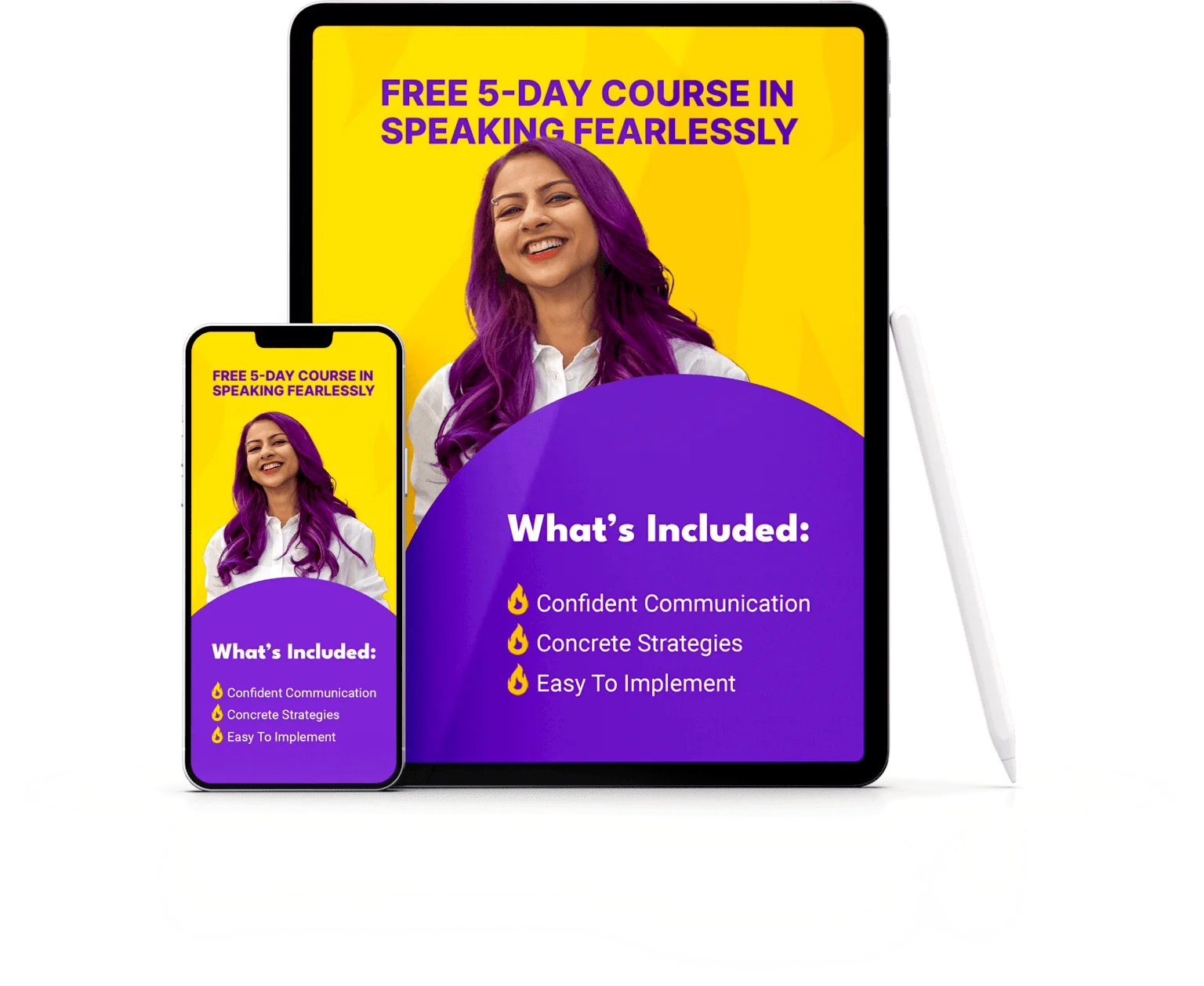
Work With Me
Free resources, privacy & transparency.
- Privacy Policy
- Cookie Policy
© 2023 Nausheen I. Chen. All rights reserved.

How it works
Transform your enterprise with the scalable mindsets, skills, & behavior change that drive performance.
Explore how BetterUp connects to your core business systems.
We pair AI with the latest in human-centered coaching to drive powerful, lasting learning and behavior change.
Build leaders that accelerate team performance and engagement.
Unlock performance potential at scale with AI-powered curated growth journeys.
Build resilience, well-being and agility to drive performance across your entire enterprise.
Transform your business, starting with your sales leaders.
Unlock business impact from the top with executive coaching.
Foster a culture of inclusion and belonging.
Accelerate the performance and potential of your agencies and employees.
See how innovative organizations use BetterUp to build a thriving workforce.
Discover how BetterUp measurably impacts key business outcomes for organizations like yours.
A demo is the first step to transforming your business. Meet with us to develop a plan for attaining your goals.

- What is coaching?
Learn how 1:1 coaching works, who its for, and if it's right for you.
Accelerate your personal and professional growth with the expert guidance of a BetterUp Coach.
Types of Coaching
Navigate career transitions, accelerate your professional growth, and achieve your career goals with expert coaching.
Enhance your communication skills for better personal and professional relationships, with tailored coaching that focuses on your needs.
Find balance, resilience, and well-being in all areas of your life with holistic coaching designed to empower you.
Discover your perfect match : Take our 5-minute assessment and let us pair you with one of our top Coaches tailored just for you.

Research, expert insights, and resources to develop courageous leaders within your organization.
Best practices, research, and tools to fuel individual and business growth.
View on-demand BetterUp events and learn about upcoming live discussions.
The latest insights and ideas for building a high-performing workplace.
- BetterUp Briefing
The online magazine that helps you understand tomorrow's workforce trends, today.
Innovative research featured in peer-reviewed journals, press, and more.
Founded in 2022 to deepen the understanding of the intersection of well-being, purpose, and performance
We're on a mission to help everyone live with clarity, purpose, and passion.
Join us and create impactful change.
Read the buzz about BetterUp.
Meet the leadership that's passionate about empowering your workforce.

For Business
For Individuals
What is nonverbal communication? 10 different types (with examples)

Jump to section
What is nonverbal communication?
10 types of nonverbal communication, examples of nonverbal communication, why is nonverbal communication so important, 5 tips for understanding nonverbal communication, how to improve nonverbal communication, enjoy better interactions.
We all rely on nonverbal communication. This is true whether playing a game of charades with your family or trying to show confidence during an important interview .
There’s a reason many of us prefer face-to-face communication over phone calls. Without seeing someone’s facial expressions, posture, and body language , it can be hard to read their feelings.
Nonverbal cues are just as important as verbalization. Nonverbal actions are key for communicating with and understanding everyone in your life.
Understanding every type of nonverbal communication can also help your career. You can show your confidence, passion, and expertise through small nonverbal communication cues. This is true whether leading a team meeting or delivering a presentation .
There are two primary forms of communication: verbal and nonverbal.
Verbal communication uses words to convey a message, whether that’s orally or in writing.
Posture, facial expressions, and eye contact are examples of nonverbal messages . We all use these cues in daily conversation, even involuntarily. Nonverbal communication also involves the way we present ourselves to others. If you walk into a meeting with your back straight and your head held high, you exude power and confidence. You project nervousness and uncertainty if you’re slumped over with your eyes on the floor.
Experts believe that approximately 70% of all human communication is nonverbal , meaning we only deliver about 30% of our messages with words.
Austrian-American author and educator Peter Drucker had it right when he said, “ The most important thing in communication is hearing what isn’t said. ”
We all perform and respond to nonverbal communication — and what we understand that no one says — daily.
Here are 10 of the most common forms of nonverbal communication:
1. Facial expressions
The look on an individual’s face is often the first thing we see. A smile, frown, or grimace tells a lot about their mood and how the subsequent conversation will go. Expressions of happiness, sadness, anger and fear are universal emotions and key forms of nonverbal communication.
2. Kinesics
Kinesics, or gestures, are conscious body movements like waving, pointing, and giving a thumbs up or down. One's culture typically determines what gestures are socially acceptable and which are rude.
For example, in Westernized countries, glancing at your watch suggests, “I need to be somewhere.” In contrast, many Middle Eastern populations consider this rude. They are more likely to believe a conversation should continue until it ends naturally.
3. Paralinguistics
Paralinguistic s (or vocalics) refers to the aspects of verbal communication that aren’t the words themselves . Your tone of voice, loudness, and pitch are common aspects of paralanguage.
This type of communication is powerful since altering your voice changes the meaning of a sentence. Think about all the ways you can use the phrase “I’m fine.” If you say it quietly, you might be feeling dejected, but if you say it forcefully, someone might detect your defensiveness.
4. Body language and posture
Crossing your legs or arms, a head nod, slouching, or sitting up straight are all examples of true body language. For example, you may have seen crime films focus on body language to further the narrative. It can also hint at what isn’t included in the dialogue.
However, this type of nonverbal communication is complex and quite subtle. Just because you observe a movement doesn’t guarantee you understand the meaning.
5. Proxemics
Proximity references how near something is. Human beings take personal space seriously. They also interpret physical distances in interactions differently.

Social and cultural expectations, personal preferences, and relationships all determine the suitable proximity. For example, if you’re in a relationship with someone, you’d expect to sit close together on the couch. On the other hand, you likely wouldn’t sit that close to a coworker.
Proxemics is an important part of interpersonal communication. Noticing when to adjust your closeness for each situation ensures you’re not making people uncomfortable.
Scientists focused on proximity biases in North America have grouped expected space as follows :
- Intimate space: Close physical contact up to 18 inches of space, typically shared between people in an intimate relationship.
- Personal space: Between 18 inches to 4 feet depending on whether you’re speaking to a stranger, casual acquaintance, or close friend.
- Social space: 4 –12 feet of space provided in social settings, like a shared office space or the distance between a presenter and their audience.
- Public space: 12 feet or more, typically observed in shopping malls and airports.
It may sound cliche, but it’s true that “The eyes are the windows to the soul.” Our eye contact is a massive factor in nonverbal communication because it can give clues to how we feel.
When we’re scared, our pupils dilate due to a surge in adrenaline. When something excites us, we blink rapidly. Maintaining eye contact generally means that someone is comfortable and telling the truth. In contrast, avoiding eye contact might suggest that they’re nervous or hiding something.
Communication by touch is called haptics. Touch is powerful because our emotions drive it. Our social class, gender, and, of course, our upbringing all determine how we respond to touch. Women generally use touch to convey care and concern, while men are more likely to convey control.
Psychologist Harry Harlow made a career in studying the impacts of touch on rhesus monkeys. Monkeys who were raised without physical contact from their mothers struggled with social interactions . We share this affect with our ancestors — physical contact at a young age improves our social skills when we're older.

8. Appearance
Your appearance is another thing people notice immediately. Your hairstyle, clothing, tattoos, piercings, and even body shape give off cues. This can encourage snap judgments from other people. There’s a reason your mother always told you to “dress to impress” for a presentation at school or a job interview.
9. Chronemics
Chronemics is the role time plays during communication. How people interpret time can be personal, cultural, or have to do with their power or status.
Have you ever waited around for a friend to show up for an event? Maybe you felt annoyed or disrespected by their laziness or lack of time management . Now imagine if your boss showed up 15 minutes late to a meeting. You might be more understanding of their busy schedule.
10. Physiological responses
Your body naturally sends out nonverbal signals that are nearly impossible to control. This includes nervous sweating, blushing, or tearing up.
Here are a few ways to practice your nonverbal communication skills personally and professionally:
In the workplace
Tone: Use your voice to show excitement, positivity, and contentment with your work. Managers want demonstrably engaged workers. Plus, your positivity will likely rub off on coworkers.
Distance: Maintain an appropriate distance from coworkers to respect their boundaries . Remember, an office is a professional space. Even if you enjoy comfortable work relationships , you should always respect someone’s physical boundaries .
Posture: You got the job. You belong here . Your ideas matter. Stand up straight and speak with your head held high.
In your personal life
Distance: Leaning in when your loved one speaks shows you’re actively listening .
Concentration: Put away distractions like video games or phones when spending time with loved ones. This shows you’re paying attention and offering them quality time.
Touch: Hugs, hand-holding, and other forms of physical touch foster intimacy between consensual parties.
Here are four reasons why understanding nonverbal messaging matters:
1. Builds trust and clarity
Nonverbal signals are far more subtle than words, but they’re no less important.
Facial expressions, body posture, and eye contact reveal the meaning behind what someone is saying, their true feelings, and if they’re listening to your half of the conversation. Someone may be able to feign interest with their words, but their body language will often reveal if they’re paying attention.
2. Bridges language gaps
Ever tried to interact with someone that didn’t speak your language? There was probably a lot of gesturing, facial expressions, and posturing — your nonverbal communication skills at work.
Outside of conversational cues, nonverbal behaviors are crucial to bridge language gaps. When two people don’t speak the same language, body language can help foster knowledge and understanding.
3. Encourages inclusivity
Everybody has different communication abilities. Learning nonverbal communication skills can help create a more diverse and inclusive workplace.
For example, people with hearing impairments might struggle to pick up on voice tone or speed. Understanding how to interpret and express nonverbal messages makes these individuals feel included and understood.
4. Leads to success
Non-verbal communication skills can help your career. For example, teachers with these skills see more success with their students. When talking with your boss, coworkers, and clients, you can use non-verbal communication to gain a competitive edge.
Effective communication requires nonverbal messaging. Understanding the types of nonverbal communication will help you connect with people in every area of your life.
The more you practice reading cues, the better you’ll become. Some things you can do include:
1. Pay attention to inconsistencies
Nonverbal communication can either reinforce or discourage what someone is saying. Do a person’s facial expressions match their words? Their tone of voice? If they do, then great.
They’re most likely being honest about whatever they’re saying. If it’s the opposite, they may be trying to hide how they truly feel.
2. Look at nonverbal signals as a whole
If you’re only paying attention to someone’s posture, you might miss a whole bunch of other clues. Nonverbal signals work in tandem to generate a complete picture of another human being.
3. Trust your instincts
Go with your gut . Your instincts are there to help guide and protect you about what someone is saying and what they truly mean.
4. Practice emotional awareness
Emotional intelligence is a significant part of navigating relationships. Being emotionally aware h elps you interpret people more accurately.
When you can read other people’s emotions and unspoken messages, you can reciprocate communication by responding in a way that shows you understand and care.
5. Don’t make assumptions
Nonverbal communication is nuanced and involves personal and cultural meaning. Don’t assume a person’s tone or body language is definitively what you think it is.
Someone might avoid eye contact because they’re shy, not deceptive. They may slouch because they’re stressed out , not doubtful of their work. If you can’t read the person’s body language, ask them how they feel.

Nonverbal communication is a necessary factor at home, work, and beyond. Often, these signals occur rapidly. Interpreting or noticing all of them can be challenging during a single conversation.
Fortunately, there's always room to improve upon these skills. To do so, try focusing on the below.
Manage stress
When we’re stressed , we can’t communicate as effectively. How you’re feeling rubs off on others, too. Take some deep breaths to relax and refocus. You’ll feel better, and you’ll be able to read people more accurately.
Pay attention to your behaviors
To learn to communicate more effectively and develop stronger emotional awareness , you must understand your nonverbal communication habits. Learning your cues will also increase self-awareness . You’ll be more in tune with your feelings and be better able to express yourself.
Think before you act
Do you raise your voice when stressed or avoid eye contact when nervous? A great way to adjust nonverbal behaviors you don’t want is to think before you act. Notice situations that cause problematic behaviors and practice taking a deep breath before reacting.
Nonverbal communication plays a prominent role in our personal and professional lives. Person-to-person contact will almost always involve some type of nonverbal communication.
Now, you know how to interpret nonverbal cues and express yourself more authentically through them. Congratulations on beginning the journey toward healthier, happier interactions.
Enhance your communication skills
Discover how personal coaching can elevate your nonverbal communication and boost interaction effectiveness.
Allaya Cooks-Campbell
With over 15 years of content experience, Allaya Cooks Campbell has written for outlets such as ScaryMommy, HRzone, and HuffPost. She holds a B.A. in Psychology and is a certified yoga instructor as well as a certified Integrative Wellness & Life Coach. Allaya is passionate about whole-person wellness, yoga, and mental health.
Nonverbal communication in the workplace: The secret to team trust
7-38-55 rule of communication: how to use for negotiation, learn types of gestures and their meanings to improve your communication, how to read body language and gain deeper emotional awareness, communication is key in the workplace. here's how to improve, why face-to-face communication matters (even with remote work), foster strong communication skills to enjoy professional success, 18 effective strategies to improve your communication skills, what is asynchronous communication, similar articles, what’s personal space learn what it means, active listening: what is it & techniques to become an active listener, effective communication in relationships: 10 tips to improve it, pandemic awkwardness holding you back 10 tips to rediscover your social self, how to overcome phone anxiety, stay connected with betterup, get our newsletter, event invites, plus product insights and research..
3100 E 5th Street, Suite 350 Austin, TX 78702
- Platform Overview
- Integrations
- Powered by AI
- BetterUp Lead™
- BetterUp Manage™
- BetterUp Care®
- Sales Performance
- Diversity & Inclusion
- Case Studies
- Why BetterUp?
- About Coaching
- Find your Coach
- Career Coaching
- Communication Coaching
- Life Coaching
- News and Press
- Leadership Team
- Become a BetterUp Coach
- BetterUp Labs
- Center for Purpose & Performance
- Leadership Training
- Business Coaching
- Contact Support
- Contact Sales
- Privacy Policy
- Acceptable Use Policy
- Trust & Security
- Cookie Preferences

How to Communicate Non-Verbally During Presentations
February 23, 2023 / Blog

Non-verbal communication is an essential aspect of conveying your message during a presentation. It can amplify your message by helping you connect with your audience, emphasize key points, and maintain the audience’s interest . Therefore, it is vital to develop your non-verbal communication skills to improve your presentation’s impact.
Need a Presentation Designed? Click Here To View Our Amazing Portfolio
Let’s talk about the best strategies for effective non-verbal communication during presentations.
Preparing for your presentation
Non-verbal communication is as important as verbal communication during a presentation. Thus, preparing for your presentation allows you to incorporate and optimize both verbal and non-verbal communication.
Here are some tips to help you prepare:
- Practice your body language and facial expressions in front of a mirror. You can also record yourself to review later. Being aware of your body language and facial expressions allows you to identify areas you need to improve.
- Dress appropriately for your audience and the message you want to convey.
Using body language
Body language lets you communicate through physical movements to convey messages and feelings.
However, while it can convey confidence, enthusiasm, and credibility, it can also undermine your message. Unprofessional body language can make you appear uncertain, uninterested, or untrustworthy.
Here are some tips to help you use your body language productively:
- Stand up straight to convey confidence, authority, and enthusiasm.
- Make and maintain eye contact with your audience. Make eye contact with individuals throughout the room, not just one individual or section.
- Use hand gestures to emphasize key points. Use gestures to indicate numbers or draw attention to specific areas of the slide.
- Use posture to convey your level of interest and engagement. Avoid slouching or leaning back, as doing so can make you appear disinterested and unprofessional, and may detract from your presentation.

Using facial expressions
Facial expressions can convey a range of emotions, attitudes, and reactions during a presentation. Using appropriate facial expressions can help your audience understand your message more effectively and engage them on an emotional level.
Here are some tips to use facial expressions effectively:
- Smile to show you’re friendly and approachable. Moreover, smiling can help you appear more confident and relaxed.
- Use a variety of facial expressions to convey different emotions.
- Avoid expressions that display discomfort, nervousness, or other negative emotions.
Effective non-verbal communication is an essential aspect of successful presentations. It can help you convey your message more effectively, connect with your audience, and keep them engaged.
By following the tips and strategies in this post, you can develop non-verbal communication skills to improve your presentation’s impact.
Partnering with SlideGenius can take the pressure off you as you prepare for your presentation. By handling the creation of visually appealing and informative presentation decks, SlideGenius can free up your time and energy to focus on the most important aspects of your presentation: preparing and rehearsing your delivery.
Contact SlideGenius today to schedule a consultation.
Popular Posts

Common Challenges in Tailoring Presentations—and Solutions

Dos and Don’ts of Pre-Seed Pitch Deck Creation

How to Write a Teaser Pitch Deck that Captivates

Tips for a Persuasive How It Works Slide

What Not to Do When Presenting Funding History

Why Raising Funds Without a Pitch Deck Can Backfire

Public Speaking: Nonverbal
Criteria for success.
- You feel confident in your movements and body posture.
- You maintain eye contact and forward-facing movements during the talk.
- You incorporate power poses when necessary.
- Your body movements flow naturally with your presentation and slides.
- Any movement that doesn’t support your main message is minimized.
Identify your purpose
A public presentation is more than just presenting information, it is also about engaging the audience and captivating their attention. If it wasn’t through our physical engagement, we might as well give the audience members an audio recording or slide deck instead. As a presenter, we attempt to liven the verbal messages with nonverbal gestures. Whether through body language, movement, or stage presence, these nonverbal components are just as important as the slides and talk you have practiced and prepared for. Incorporating conscious movements that serve to enhance how your message is perceived by your audience can help you:
- Engage your audience. Posture, gestures or movements, and your physical location on the stage are all factors that can be incorporated to create a story-telling effect that will keep your audience engaged throughout your presentation.
- Feel more confident. Strong body postures (e.g., power poses) convey confidence and a sense of importance during your talk.
Analyze your audience
Many audience members will arrive with the intention of learning more about your work and gaining some insight about your field. You can do more by also delivering an impactful and engaging talk that viewers can take home and remember. Audience types will dictate how you present yourself. For example, formal talks require formal attire, and this is also true in the types of nonverbal communication you can incorporate. Defined posture and deliberate movements are a must for professional talks, whereas more dynamic movements may be appealing for more casual and friendly presentations.
Similarly, the environment in which you are presenting will also determine your style. Poster presentations can be more informal with casual movements to guide the viewer. Department talks, on the other hand, should have movements that flow fluidly with your talk to guide the audience in your longer discussions.
Use eye contact to engage your audience
Possibly one of the most intimidating aspects of a talk is to look at the audience and to see their eyes gazing back at you. It is very common to escape eye contact by looking at your notes, the floor, or turning your back on your audience to face your slides. However, to be an effective presenter it is necessary to overcome these crutches in order to engage your audience. Making eye contact will help the audience feel important, like you are actually talking to them and not just giving a rehearsed speech.
If you already feel comfortable maintaining eye contact, remember to engage the entire audience. A few suggestions are:
- If it’s a large room, turn your head or even body to talk to all corners of the room, not just the people in the middle.
- Rather than just scanning the audience, can you take time to make one-on-one eye contact with individuals? Use this as an opportunity to gauge the audience’s level of interest. Seeing how they respond to your slides, transitions, etc. can help you adjust your talk as you go.
If making eye contact is challenging for you, here are two suggestions to help you work on this skill:
- Rather than trying to make eye contact with individuals, try looking at someone’s forehead, a colorful shirt, or the cushion of someone’s seat to create the illusion that you are making eye contact with the general audience. Alternatively, if picking out details is too distracting, you can look at or just above people’s heads to give the illusion of making eye contact.
- Once you feel comfortable looking into the audience, pick one or two places and go back and forth between these places during your talk to engage the entire room.
Emphasize deliberate movements and minimize unnecessary distractions (maximize signal-to-noise)
Here, we define signal as any movements that add substance to your talk and further engages the audience, such as conveying a message with your hands, or making eye contact with the audience.
Noise, on the other hand, is any unnecessary movements that distract the viewers, such as fidgeting or repetitive motions. Move with purpose. Do not ruffle your pockets or rock back and forth. Instead, present a straight, upright posture with arm movements that match the pace and flow of your talk. Adding purposeful movement to signify changes in ideas or to emphasize important points can add another layer of engagement to your talk. Some examples include:
- If you are comparing two concepts, physically weigh them out with your hands to convey the difference as if your hands were a scale.
- Casually walk to the other side of the stage when transitioning between ideas to physically cue the viewers that there is a change in topic.
- With a straight arm, point in the direction of the slide that has an important message. Make your movement distinct to indicate that the audience should focus on the slide, and not you.
Overall, this “art form” is unique to each person based on level of comfort and ability. We highly recommend using the Communication Lab to ask about how you can best utilize body movements to further enhance your talk. Alternatively, ask a friend for feedback, film yourself, or practice in front of a mirror to get a sense at what actions you naturally do during a talk, and reflect on how to change or enhance them.
(The metaphor of “signal-to-noise ratio” comes from Jean-luc Doumont’s book Trees, Maps, and Theorems .)
Use good posture and incorporate power poses
Many of us are rarely conscious of our posture, yet this is the first impression you will make to your audience even before you speak. A straight back and a level chin with your eyes facing the audience will show that you are prepared and ready.
Power poses can help assert confidence and importance during your talk. You are, in fact, the most important person in the room, so use power poses to make it look that way! What makes power poses distinct from low-power (or submissive) poses is the control of space. Hands on the side and a slightly wider stance command space on the stage and demands attention. Of course, overly dramatic, arrogant, or otherwise off-putting stances and posture should be avoided. Use a friend or video to find a power pose that makes you feel confident but doesn’t detract from your overall talk.
How to Practice
Non-verbal engagement is part of our daily lives, so pay attention to your movements when you interact with friends or co-workers. With practice, you will be able to naturally deliver a strong presentation when the time comes. Overall, things to consider are:
- Be conscious of your posture when standing and interacting with friends.
- Look people in the eye! Attempt to make eye contact with those you talk to.
- Pay attention to your small and fidget-like movements, even while by yourself. If these unwanted habits go unnoticed during everyday life, you can expect these habits to creep into your talk without you knowing.
Finally, make an appointment with the Comm Lab if you ever want to practice one-on-one or to discuss your concerns related to your non-verbal presentation style.

Additional Resources
- Common Challenges and Fixes for Verbal and Nonverbal Communication – An extensive reference table created by the BE Communication Lab
- “The Importance of Nonverbal Communication” – A quick read with fun statistics about the importance of nonverbal communication and additional concrete suggestions for improving your skills.
- “Your Body Language May Shape Who You Are” – A TED Talk on the effects of power poses and how to incorporate them into your daily life.
- Member Login
- Board Login

Nonverbal Communication: Presentation Tips in a Virtual Workplace
by Tory Freeman | Jun 11, 2021 | General , Personal Development | 0 comments

With COVID-19 making many conferences, meetings, and businesses operate remotely, it is likely in the last 12 months you have had to: 1.) become a Zoom expert, 2.) repaint the wall behind your desk so it looks attractive, and 3.) invest in a high-tech microphone and camera. If all of this wasn’t stressful enough, presenting online gives us other challenges, including the horror of being able to see our own faces while we present, adding more stress to an already stressful situation. Speaking or presenting online gives other difficulties as well, as you have to think about how you show emotion through the camera, create connection remotely, pose with camera angles, and what you do with your hands.
Why Nonverbals are Important
Being able to connect using compelling nonverbal communication is powerful and a necessary part of any presentation, meeting, or sales interaction. Nonverbal communication is the other part of the communication equation, in which verbal and nonverbal communication are the two parts of the whole. Excellent communicators utilize both, and when presenting in virtual settings, it’s not just the words you say, but the manner in which you say them — the nonverbal communication that accompanies them can often speak louder than words. Dr. Kory Floyd, a Professor of Communication at the University of Arizona, defines nonverbal communication as “comprising any behaviors with which we communicate without the use of words.” These would include eye-contact, physical appearance (including clothes, or accessories such as glasses), body movement, gestures, facial expressions, and vocal variety. “Vocal variety” comprises the ways in which you use your voice, such as rate, pitch, pauses, and volume. Utilizing nonverbal communication can make a bland presentation come alive, give flair to a TED Talk, or create connection with your audience during a meeting.
That’s really the power of nonverbal communication — connection. To make us feel connected or close to someone. This phenomenon is often studied in instructional or business settings, and is called nonverbal immediacy . Dr. Floyd says, “Nonverbal immediacy is the use of nonverbal behavior to minimize psychological distance and create emotional closeness between people. It is useful in any setting (virtual or not) in which a sense of closeness is desirable. It can be achieved through eye contact, warm facial expressions and vocal tones, forward leaning, proximity, touch, and other behaviors that help to create or maintain connection between people.”
It is a worthy goal to try to increase nonverbal immediacy when interacting and presenting online, as it will help your audience to feel connected to you.
Sara Blakely, founder & CEO of Spanx, is magical at utilizing nonverbal immediacy. In this interview , she smiles warmly, uses a lot of eye-contact with the host, has a large range of gestures, laughs, and makes the audience absolutely fall in love with her. The good news is that you can make the audience connect with you by utilizing these following four types of nonverbal communication.
1.Facial Expressions
2. eye contact.
“The most important advice is to look at the camera, not at the image,” says Dr. Floyd, who suggests it’s important to vary your gaze whether in person, or remote.
3. Body Movement and Gestures
4. vocal variety.
- Bipolar Disorder
- Therapy Center
- When To See a Therapist
- Types of Therapy
- Best Online Therapy
- Best Couples Therapy
- Best Family Therapy
- Managing Stress
- Sleep and Dreaming
- Understanding Emotions
- Self-Improvement
- Healthy Relationships
- Student Resources
- Personality Types
- Guided Meditations
- Verywell Mind Insights
- 2024 Verywell Mind 25
- Mental Health in the Classroom
- Editorial Process
- Meet Our Review Board
- Crisis Support
Types of Nonverbal Communication
Often you don't need words at all
Kendra Cherry, MS, is a psychosocial rehabilitation specialist, psychology educator, and author of the "Everything Psychology Book."
:max_bytes(150000):strip_icc():format(webp)/IMG_9791-89504ab694d54b66bbd72cb84ffb860e.jpg)
Tim Robberts / Getty Images
Why Nonverbal Communication Is Important
- How to Improve
Nonverbal communication means conveying information without using words. This might involve using certain facial expressions or hand gestures to make a specific point, or it could involve the use (or non-use) of eye contact, physical proximity, and other nonverbal cues to get a message across.
A substantial portion of our communication is nonverbal. In fact, some researchers suggest that the percentage of nonverbal communication is four times that of verbal communication, with 80% of what we communicate involving our actions and gestures versus only 20% being conveyed with the use of words.
Every day, we respond to thousands of nonverbal cues and behaviors, including postures, facial expressions, eye gaze, gestures, and tone of voice. From our handshakes to our hairstyles, our nonverbal communication reveals who we are and impacts how we relate to other people.
9 Types of Nonverbal Communication
Scientific research on nonverbal communication and behavior began with the 1872 publication of Charles Darwin's The Expression of the Emotions in Man and Animals . Since that time, a wealth of research has been devoted to the types, effects, and expressions of unspoken communication and behavior .
Nonverbal Communication Types
While these signals can be so subtle that we are not consciously aware of them, research has identified nine types of nonverbal communication. These nonverbal communication types are:
- Facial expressions
- Paralinguistics (such as loudness or tone of voice)
- Body language
- Proxemics or personal space
- Eye gaze, haptics (touch)
- Artifacts (objects and images)
Facial Expressions
Facial expressions are responsible for a huge proportion of nonverbal communication. Consider how much information can be conveyed with a smile or a frown. The look on a person's face is often the first thing we see, even before we hear what they have to say.
While nonverbal communication and behavior can vary dramatically between cultures, the facial expressions for happiness, sadness, anger, and fear are similar throughout the world.
Deliberate movements and signals are an important way to communicate meaning without words. Common gestures include waving, pointing, and giving a "thumbs up" sign. Other gestures are arbitrary and related to culture.
For example, in the U.S., putting the index and middle finger in the shape of a "V" with your palm facing out is often considered to be a sign of peace or victory. Yet, in Britain, Australia, and other parts of the world, this gesture can be considered an insult.
Nonverbal communication via gestures is so powerful and influential that some judges place limits on which ones are allowed in the courtroom, where they can sway juror opinions. An attorney might glance at their watch to suggest that the opposing lawyer's argument is tedious, for instance. Or they may roll their eyes during a witness's testimony in an attempt to undermine that person's credibility.
Paralinguistics
Paralinguistics refers to vocal communication that is separate from actual language. This form of nonverbal communication includes factors such as tone of voice, loudness, inflection, and pitch.
For example, consider the powerful effect that tone of voice can have on the meaning of a sentence. When said in a strong tone of voice, listeners might interpret a statement as approval and enthusiasm. The same words said in a hesitant tone can convey disapproval and a lack of interest.
Body Language and Posture
Posture and movement can also provide a great deal of information. Research on body language has grown significantly since the 1970s, with popular media focusing on the over-interpretation of defensive postures such as arm-crossing and leg-crossing, especially after the publication of Julius Fast's book Body Language .
While these nonverbal communications can indicate feelings and attitudes , body language is often subtle and less definitive than previously believed.
People often refer to their need for "personal space." This is known as proxemics and is another important type of nonverbal communication.
The amount of distance we need and the amount of space we perceive as belonging to us are influenced by several factors. Among them are social norms , cultural expectations, situational factors, personality characteristics, and level of familiarity.
The amount of personal space needed when having a casual conversation with another person can vary between 18 inches and four feet. The personal distance needed when speaking to a crowd of people is usually around 10 to 12 feet.
The eyes play a role in nonverbal communication, with such things as looking, staring, and blinking being important cues. For example, when you encounter people or things that you like, your rate of blinking increases and your pupils dilate.
People's eyes can indicate a range of emotions , including hostility, interest, and attraction. People also often utilize eye gaze cues to gauge a person's honesty. Normal, steady eye contact is often taken as a sign that a person is telling the truth and is trustworthy. Shifty eyes and an inability to maintain eye contact, on the other hand, is frequently seen as an indicator that someone is lying or being deceptive.
However, some research suggests that eye gaze does not accurately predict lying behavior.
Communicating through touch is another important nonverbal communication behavior. Touch can be used to communicate affection, familiarity, sympathy, and other emotions .
In her book Interpersonal Communication: Everyday Encounters , author Julia Wood writes that touch is also often used to communicate both status and power. High-status individuals tend to invade other people's personal space with greater frequency and intensity than lower-status individuals.
Sex differences also play a role in how people utilize touch to communicate meaning. Women tend to use touch to convey care, concern, and nurturance. Men, on the other hand, are more likely to use touch to assert power or control over others.
There has been a substantial amount of research on the importance of touch in infancy and early childhood. Harry Harlow's classic monkey study , for example, demonstrated how being deprived of touch impedes development. In the experiments, baby monkeys raised by wire mothers experienced permanent deficits in behavior and social interaction.
Our choice of clothing, hairstyle, and other appearance factors are also considered a means of nonverbal communication. Research on color psychology has demonstrated that different colors can evoke different moods. Appearance can also alter physiological reactions, judgments, and interpretations.
Just think of all the subtle judgments you quickly make about someone based on their appearance. These first impressions are important, which is why experts suggest that job seekers dress appropriately for interviews with potential employers.
Researchers have found that appearance can even play a role in how much people earn. Attractive people tend to earn more and receive other fringe benefits, including higher-quality jobs.
Culture is an important influence on how appearances are judged. While thinness tends to be valued in Western cultures, some African cultures relate full-figured bodies to better health, wealth, and social status.
Objects and images are also tools that can be used to communicate nonverbally. On an online forum, for example, you might select an avatar to represent your identity and to communicate information about who you are and the things you like.
People often spend a great deal of time developing a particular image and surrounding themselves with objects designed to convey information about the things that are important to them. Uniforms, for example, can be used to transmit a tremendous amount of information about a person.
A soldier will don fatigues, a police officer will wear a specific uniform, and a doctor will wear a white lab coat. At a mere glance, these outfits tell others what that person does for a living. That makes them a powerful form of nonverbal communication.
Nonverbal Communication Examples
Think of all the ways you communicate nonverbally in your own life. You can find examples of nonverbal communication at home, at work, and in other situations.
Nonverbal Communication at Home
Consider all the ways that tone of voice might change the meaning of a sentence when talking with a family member. One example is when you ask your partner how they are doing and they respond with, "I'm fine." How they say these words reveals a tremendous amount about how they are truly feeling.
A bright, happy tone of voice would suggest that they are doing quite well. A cold tone of voice might suggest that they are not fine but don't wish to discuss it. A somber, downcast tone might indicate that they are the opposite of fine but may want to talk about why.
Other examples of nonverbal communication at home include:
- Going to your partner swiftly when they call for you (as opposed to taking your time or not responding at all)
- Greeting your child with a smile when they walk into the room to show that you're happy to see them
- Leaning in when your loved one speaks to show that you are listening and that you are interested in what they're saying
- Shoving your fist into the air when you're upset that something isn't working
Nonverbal Communication in the Workplace
You can also find nonverbal communication in the workplace. Examples of this include:
- Looking co-workers in the eye when speaking with them to be fully engaged in the interaction
- Throwing your hands in the air when you are frustrated with a project
- Using excitement in your voice when leading work meetings to project your passion for a specific topic
- Walking down the hall with your head held high to convey confidence in your abilities
Nonverbal Communication in Other Situations
Here are a few additional examples of nonverbal communication that say a lot without you having to say anything at all:
- Greeting an old friend at a restaurant with a hug, handshake, or fist bump
- Placing your hand on someone's arm when they are talking to you at a party to convey friendliness or concern
- Rolling your eyes at someone who is chatting excessively with a store clerk as a line begins to form
- Scowling at someone who has cut you off in traffic, or "flipping them the bird"
Nonverbal communication serves an important role in conveying meaning. Some benefits it provides include:
- Strengthening relationships : Nonverbal communication fosters closeness and intimacy in interpersonal relationships.
- Substituting for spoken words : Signaling information that a person might not be able to say aloud. This can be helpful in situations where a person might not be heard (such as a noisy workplace) or in therapy situations where a mental health professional can look at nonverbal behaviors to learn more about how a client might be feeling.
- Reinforcing meaning : Matching nonverbal communication to spoken words can help add clarity and reinforce important points.
- Regulating conversation : Nonverbal signals can also help regulate the flow of conversation and indicate both the start and end of a message or topic.
Nonverbal communication is important because it can provide valuable information, reinforce the meaning of spoken words, help convey trust, and add clarity to your message.
How to Improve Your Nonverbal Communication Skills
If you want to develop more confident body language or improve your ability to read other people's nonverbal communication behaviors, these tips can help:
- Pay attention to your own behaviors : Notice the gestures you use when you're happy versus when you're upset. Think about how you change the tone of your voice depending on the emotions you are feeling. Being aware of your own nonverbal communication tendencies is the first step to changing the ones you want to change. It can also give you insight into how you're feeling if you're having trouble putting it into words.
- Become a student of others : It can also be helpful to consider how others around you communicate nonverbally. What do their facial expressions say? What type of gestures do they use? Becoming familiar with their nonverbal communication patterns helps you recognize when they might be feeling a certain way quicker because you're actively watching for these cues. It can also help you recognize nonverbal behaviors you may want to adopt yourself (such as standing tall when talking to others to display self-confidence ).
- Look for incongruent nonverbal cues : Do you say that you're fine, then slam cupboard doors to show that you're upset? This can give those around you mixed messages. Or maybe when someone is speaking with you, they are saying yes while shaking their head no. This is another example of incongruent behavior. Both can be signs of feeling a certain way but not yet being ready to admit or discuss it.
- Think before you act : If your middle finger seems to automatically fly up when a car cuts you off—even if your young child is in the back seat, causing you to regret it as soon as it happens—you can work to stop this reaction. Train yourself to stop and think before you act. This can help you eliminate or replace nonverbal behaviors that you've been wanting to change.
- Ask before you assume : Certain types of nonverbal communication can mean different things in different cultures. They can also vary based on someone's personality . Before assuming that a person's body language or tone means something definitively, ask. "I notice that you won't look me in the eye when we speak. Are you upset with me?" Give them the opportunity to explain how they are feeling so you know for sure.
A Word From Verywell
Nonverbal communication plays an important role in how we convey meaning and information to others, as well as how we interpret the actions of those around us.
The important thing to remember when looking at nonverbal behaviors is to consider the actions in groups. Consider what a person says verbally, combined with their expressions, appearance, and tone of voice and it can tell you a great deal about what that person is really trying to say.
American Psychological Association. Nonverbal communication (NVC) .
Hull R. The art of nonverbal communication in practice . Hear J . 2016;69(5);22-24. doi:10.1097/01.HJ.0000483270.59643.cc
Frith C. Role of facial expressions in social interactions . Philos Trans R Soc B Biol Sci . 2009;364(1535):3453-8. doi:10.1098/rstb.2009.0142
Goldin-Meadow S. How gesture works to change our minds . Trends Neurosci Educ . 2014;3(1):4-6. doi:10.1016/j.tine.2014.01.002
Guyer JJ, Briñol P, Vaughan-Johnston TI, Fabrigar LR, Moreno L, Petty RE. Paralinguistic features communicated through voice can affect appraisals of confidence and evaluative judgments . J Nonverbal Behav . 2021;45(4):479-504. doi:10.1007/s10919-021-00374-2
Abdulghafor R, Turaev S, Ali MAH. Body language analysis in healthcare: An overview . Healthcare (Basel) . 2022;10(7):1251. doi:10.3390/healthcare10071251
Mccall C, Singer T. Facing off with unfair others: introducing proxemic imaging as an implicit measure of approach and avoidance during social interaction . PLoS One . 2015;10(2):e0117532. doi:10.1371/journal.pone.0117532
Wiseman R, Watt C, ten Brinke L, Porter S, Couper SL, Rankin C. The eyes don't have it: lie detection and Neuro-Linguistic Programming . PLoS One . 2012;7(7):e40259. doi:10.1371/journal.pone.0040259
Sekerdej M, Simão C, Waldzus S, Brito R. Keeping in touch with context: Non-verbal behavior as a manifestation of communality and dominance . J Nonverbal Behav . 2018;42(3):311-326. doi:10.1007/s10919-018-0279-2
Bambaeeroo F, Shokrpour N. The impact of the teachers' non-verbal communication on success in teaching . J Adv Med Educ Prof . 2017;5(2):51-59.
Dilmaghani M. Beauty perks: Physical appearance, earnings, and fringe benefits . Economics & Human Biology . 2020;38:100889. doi:10.1016/j.ehb.2020.100889
Darwin C. The Expression of the Emotions in Man and Animals .
Wood J. Interpersonal Communication: Everyday Encounters .
By Kendra Cherry, MSEd Kendra Cherry, MS, is a psychosocial rehabilitation specialist, psychology educator, and author of the "Everything Psychology Book."
- Top Courses
- Online Degrees
- Find your New Career
- Join for Free
What Is Effective Communication? Skills for Work, School, and Life
Discover how improving your communication skills can benefit your career, education, and personal life.
![communication non verbal presentation [Featured image] A group of professionals in business suits sit in front of microphones at an international press conference.](https://d3njjcbhbojbot.cloudfront.net/api/utilities/v1/imageproxy/https://images.ctfassets.net/wp1lcwdav1p1/3dvRIjOK129vMZLlqGnc7N/17b18acb654be2f77a1315a670b8c9c1/GettyImages-936308944.jpg?w=1500&h=680&q=60&fit=fill&f=faces&fm=jpg&fl=progressive&auto=format%2Ccompress&dpr=1&w=1000)
Communication is a part of everyday life, whether we communicate in person or on the countless digital platforms available to us. But how much of our communication actually reaches the intended audience or person the way we hoped? Effective communication requires us to be clear and complete in what we are trying to express.
Being an effective communicator in our professional and personal lives involves learning the skills to exchange information with clarity, empathy, and understanding. In this article, we’ll define what effective communication looks like, discuss its benefits, and offer ways to improve your communication skills.
What is effective communication?
Effective communication is the process of exchanging ideas, thoughts, opinions, knowledge, and data so that the message is received and understood with clarity and purpose. When we communicate effectively, both the sender and receiver feel satisfied.
Communication occurs in many forms, including verbal and non-verbal, written, visual, and listening. It can occur in person, on the internet (on forums, social media, and websites), over the phone (through apps, calls, and video), or by mail.
For communication to be effective, it must be clear , correct , complete , concise , and compassionate . We consider these to be the 5 Cs of communication, though they may vary depending on who you’re asking.
While the effectiveness of communication can be difficult to measure, its impact is hard to deny. According to one study, surveyed companies in the United States and United Kingdom with at least 100,000 employees lost $62.4 million per year on average due to poor communication. On the flip side, companies led by effective communicators had nearly 50 percent higher total returns to shareholders over companies with less effective communicators at the helm [ 1 ].

Build job-ready skills with a Coursera Plus subscription
- Get access to 7,000+ learning programs from world-class universities and companies, including Google, Yale, Salesforce, and more
- Try different courses and find your best fit at no additional cost
- Earn certificates for learning programs you complete
- A subscription price of $59/month, cancel anytime
Benefits of effective communication
The benefits of communication effectiveness can be witnessed in the workplace, in an educational setting, and in your personal life. Learning how to communicate well can be a boon in each of these areas.
In the workplace, effective communication can help you:
Manage employees and build teams
Grow your organization more rapidly and retain employees
Benefit from enhanced creativity and innovation
Become a better public speaker
Build strong relationships and attract more opportunities for you or your organization
Read more: Why Is Workplace Communication Important? + How to Improve It
In your personal life, effective communication can lead to:
Improved social, emotional, and mental health
Deeper connections with people you care about
New bonds based on trust and transparency
Better problem–solving and conflict resolution skills
Say it with your body
In face-to-face conversation, body language plays an important role. Communication is 55 percent non-verbal, 38 percent vocal (tone and inflection), and 7 percent words, according to Albert Mehrabian, a researcher who pioneered studies on body language [ 2 ]. Up to 93 percent of communication, then, does not involve what you are actually saying.
Positive body language is open—your posture is upright and receptive, your palms are open, you lean in when speaking or listening, and nod encouragingly. Negative body language can include biting your lip nervously, looking bored, crossing your arms, putting your hands on your hips, or tapping your foot impatiently.
How to improve your communication skills
Communication, like any other skill, is one you can improve upon with practice. Here are a few ways to start improving your communication skills, whether at home or on the job.
1. Consider your audience.
Who are you communicating with? Make sure you are aware of your audience—those you intend to communicate with may differ from those who actually receive your messages. Knowing your audience can be key to delivering the right messages effectively. Their age, race, ethnicity, gender, marital status, income, education level, subject knowledge, and professional experience can all affect how they’ll receive your message.
If you’re advertising a fast food restaurant, for example, you might want to deliver your message to an audience that’s likely to be hungry. This could be a billboard on the side of a busy highway that shows a giant cheeseburger and informs drivers that the closest location is just two miles away.
Or suppose you’re announcing your engagement to your family. You might host a gathering afterwards to celebrate, send them photos of the engagement in a group chat, surprise them in conversation over dinner, or tag your family members in your announcement on social media. Your chosen form of communication will depend on your family dynamics.
2. Practice active listening.
Active listening is the practice of giving your full attention in a communication exchange.
Some techniques include paying attention to body language, giving encouraging verbal cues, asking questions, and practicing non-judgment. Before executing your communication, be sure to consider your audience and practice active listening to get to the heart of their needs and desires. This way, you can improve your communication as a counselor, social worker, marketer, professor, colleague, or friend.
Here are some examples of active listening in practice:
If you work in marketing, you might engage in social listening to gather consumer data on social media platforms like Instagram and TikTok.
If you are a professor, you might take advantage of end-of-semester feedback forms and act on your students' needs by hosting one-on-one meetings during office hours. Likewise, your students might choose to participate in discussions after your lecture or at least sit attentively and ask questions.
If you are a team leader, you might read Slack messages from your teammates, gauge that they are frustrated with the workload, and respond by resetting priorities for the next few weeks. This communicates to the team that their voices are heard.
If you are a parent, you might have a disagreement with your child about finishing their homework, but if you probe deeper with open communication, they may confess that their teacher made a discouraging comment that left them unmotivated.
Read more: What Is Active Listening and How Can You Improve This Key Skill?
3. Make your message as clear as possible.
Once you have successfully identified your audience and listened to their intentions, needs, and desires, you may have something to communicate. To do this effectively, turn to the 5 Cs of communication to ensure your message is:
Compassionate
Prepare to communicate in a way that achieves most of these characteristics.
4. Use the right medium or platform.
Using the right medium or platform to communicate matters. Effective communication requires you to consider whether you need to meet in person or if Zoom would suffice. Is your message casual enough to use WhatsApp, or would a formal email be more efficient and thorough? If you are catching up with a friend, do you two prefer to talk on the phone or via old-fashioned letters? Whatever you choose should be intuitive and appropriate for you and your current situation.
You might assess the priority level and the type of communication needed. In a marketing campaign, is there a visual component on Instagram or is it a spoken podcast ad? Will the platform be a Facebook post, product placement in a film, or a printed poster hung in cafes? For a university lecture, do students prefer to be online or meet in person? Will there be a discussion afterward, and would it be fruitful to conduct it in a pub, cafe, or in a field outdoors?
By considering your audience, practicing active listening, clarifying your communication, and choosing the right medium or environment, you are well on your way to exercising communication effectiveness.
Effective communication starts here
Start building better communication with Improving your Communication Skills from the University of Pennsylvania, Successful Negotiation: Essential Strategies and Skills from the University of Michigan, or Effective Communication: Writing, Design, and Presentation from the University of Colorado Boulder.
Article sources
PRovoke Media. " The Cost Of Poor Communications , https://www.provokemedia.com/latest/article/the-cost-of-poor-communications." Accessed January 17, 2024.
The University of Texas Permian Basin. " How Much of Communication Is Nonverbal? , https://online.utpb.edu/about-us/articles/communication/how-much-of-communication-is-nonverbal/." Accessed January 17, 2024.
Keep reading
Coursera staff.
Editorial Team
Coursera’s editorial team is comprised of highly experienced professional editors, writers, and fact...
This content has been made available for informational purposes only. Learners are advised to conduct additional research to ensure that courses and other credentials pursued meet their personal, professional, and financial goals.

- My presentations
Auth with social network:
Download presentation
We think you have liked this presentation. If you wish to download it, please recommend it to your friends in any social system. Share buttons are a little bit lower. Thank you!
Presentation is loading. Please wait.
NON-VERBAL COMMUNICATION
Published by Marian Garrison Modified over 8 years ago
Similar presentations
Presentation on theme: "NON-VERBAL COMMUNICATION"— Presentation transcript:
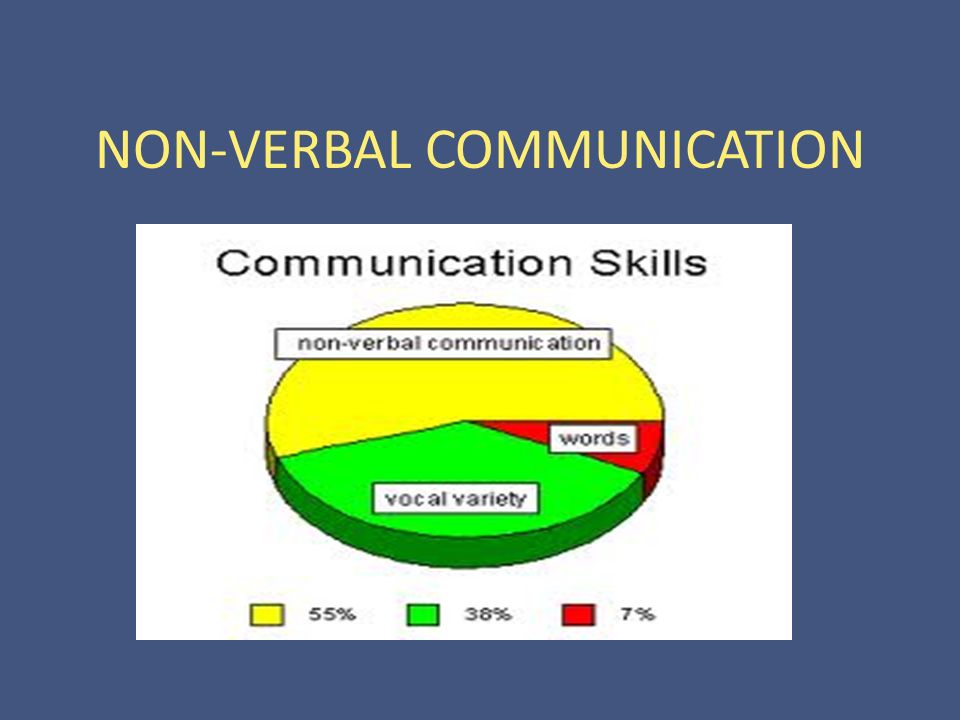
Reaching for Excellence, Trina Pulliam and Judy Garmaise

Nonverbal Communication

Nonverbal Components of Delivery

Nonverbal Communication and Teamwork

Nonverbal Communication Actions, as opposed to words, that send messages Body language, behavior Some messages are subtle, such as posture Can be so strong.

Delivering Your Speech. Why Is Delivery Important? Delivery: The way you communicate messages orally and visually through your use of voice, face, and.

Chapter Eleven Delivering the Speech. Chapter Eleven Table of Contents zQualities of Effective Delivery zThe Functions of Nonverbal Communication in Delivery.

Nonverbal Communication Chapter 5 Person to Person Chapter 5 Person to Person.

Nonverbal Communication. A. General Information 1.Definition – All the behaviors and elements of people, other than words, that convey meaning 2. At least.

1 Copyright © 2011, 2007, 2003, 1999 by Saunders, an imprint of Elsevier Inc. All rights reserved. Interpersonal Skills, Human Behavior & Non-Verbal Communication.

OUR COMMUNICATION : -Words -How we say these words (our tone, pitch, volume, etc.) -Non-verbal communication.

NONVERBAL COMMUNICATION

Non-Verbal Communication

Non-Verbal Communication and Body language

Understanding Non- Verbal Communication MRS. DOBBINS.

Body Language. In 1971, US Educational Psychologist Albert Mehrabian published his famous 7%-38%-55% Rule on non- verbal communication. He found that.

The various types of nonverbal communication are basically forms of communication without words. You might be led into thinking that this form is rather.

Body Language and Facial Expression

TYPES OF COMMUNICATION
About project
© 2024 SlidePlayer.com Inc. All rights reserved.
Got any suggestions?
We want to hear from you! Send us a message and help improve Slidesgo
Top searches
Trending searches

26 templates

great barrier reef
17 templates

15 templates

football soccer
22 templates
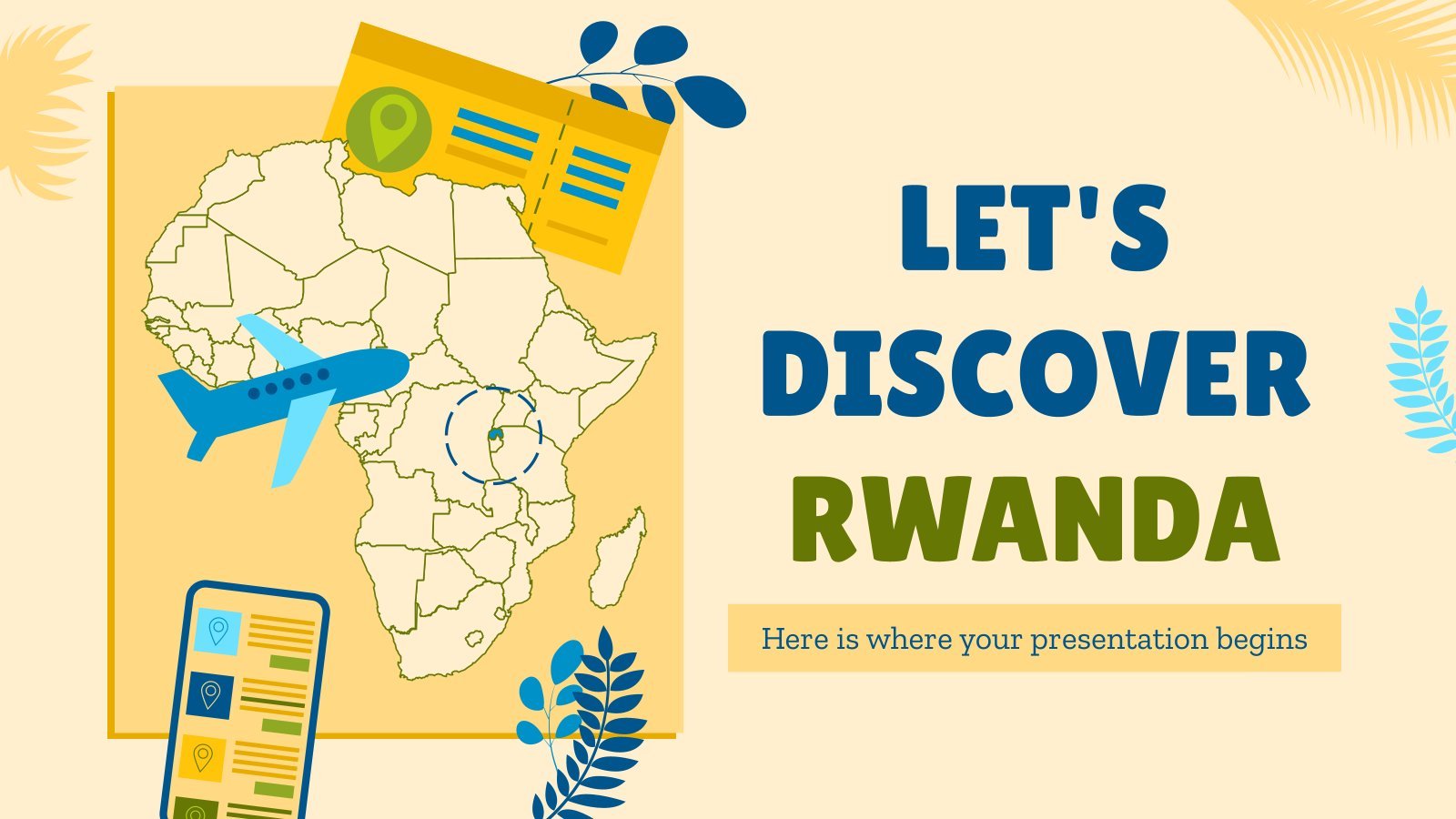
18 templates

49 templates
Nonverbal Communication Lesson for Elementary
It seems that you like this template, nonverbal communication lesson for elementary presentation, free google slides theme, powerpoint template, and canva presentation template.
Do you want to teach nonverbal communication? Sometimes we are too focused on what we communicate with words that we forget the power of everything that is communicated through gestures, facial expressions or eye contact. Thus, this template is prepared for a elementary school lesson for you to teach about nonverbal communication. We have included cartoon-style illustrations that express different emotions, to emphasize how we communicate with just a facial expression. You have other resources such as charts, graphs or maps to make your lesson more productive.
Features of this template
- 100% editable and easy to modify
- 35 different slides to impress your audience
- Contains easy-to-edit graphics such as graphs, maps, tables, timelines and mockups
- Includes 500+ icons and Flaticon’s extension for customizing your slides
- Designed to be used in Google Slides, Canva, and Microsoft PowerPoint
- 16:9 widescreen format suitable for all types of screens
- Includes information about fonts, colors, and credits of the resources used
How can I use the template?
Am I free to use the templates?
How to attribute?
Attribution required If you are a free user, you must attribute Slidesgo by keeping the slide where the credits appear. How to attribute?
Related posts on our blog.

How to Add, Duplicate, Move, Delete or Hide Slides in Google Slides

How to Change Layouts in PowerPoint

How to Change the Slide Size in Google Slides
Related presentations.

Premium template
Unlock this template and gain unlimited access

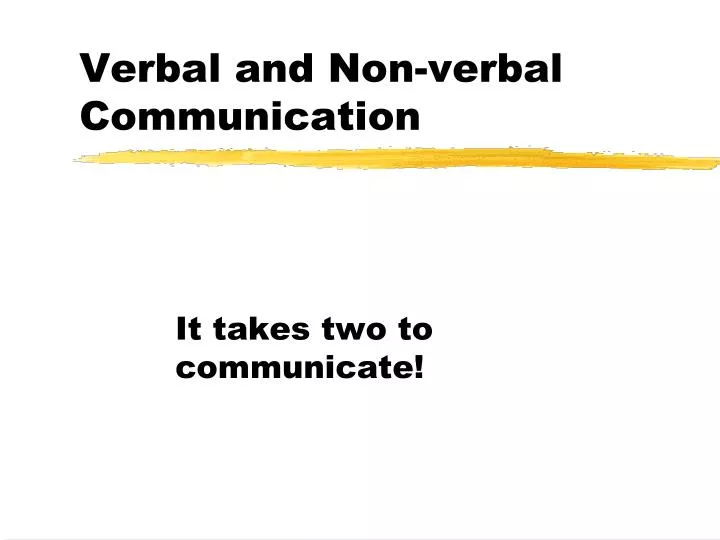
Verbal and Non-verbal Communication
Jul 18, 2012
700 likes | 2.43k Views
Verbal and Non-verbal Communication. It takes two to communicate!. Four Elements of Communication. Sender -generates information, thoughts, ideas or feelings Message - generated by sender and responded to by receiver. Four Elements of Communication.
Share Presentation
- mental ability
- spell correctly
- emr electronic medical record
- ehr electronic health record
- refresh memory

Presentation Transcript
Verbal and Non-verbal Communication It takes two to communicate!
Four Elements of Communication • Sender-generates information, thoughts, ideas or feelings • Message- generated by sender and responded to by receiver.
Four Elements of Communication • Channel-medium in which message in transmitted • Visual-seeing • Auditory-hearing • Kinesthetics-feeling, touch • Receiver
Verbal Communication • Loudness • Fluency • Rate of Speech • Affect • Language used
Nonverbal Communication • Reinforces, supports and enhances verbal messages • 55%-of messages are non-verbal • 38% are volume and tone • Leaving only 7% as verbal words
Examples of Non-Verbal • Eye Contact • Facial Expression • Gesture & Posture • Body Orientation • Distance • Appearance
Listening Components • Hearing-process of perceiving sounds • Attending- decision of listener based on wants/needs • Understanding-interpreting • Remembering
Barriers to Listening • Physical and mental characteristics-ability to hear, mental ability • Preconceptions • Self Absorption-preoccupied
Health Literacy • What is Health Literacy? • Ability to read, understand and act on medical information • Examples: services, appointments, directions which all affect the patients health decisions • Estimated half of all American adults lack that skill
Health Literacy • Clinicians need to address this issue • $73 billion dollar expenditures due to low health literacy • This increases costs due to longer hospital stays, unnecessary doctor visits, neglect to fill prescriptions or follow them
Health Literacy • Most people read at an 8th grade level and sometimes lower • People do not want anyone to know they can not read or do not understand
Health Literacy • American Medical Association has established a protocol to by used by all clinicians to make sure patients understand • Watch the Health Literacy video
Four Behavior Styles That Affect Communication • Non-Assertive • Aggressive • Passive Aggressive • Assertive
Space and Territoriality • Social Space-4-12 ft appropriate for introduction • Personal Space-18”-4ft close enough for personal conversation • Intimate Space- 0-18” appropriate for exams, assessments
Written Communication Examples of Written Communications in Health Care • Prescriptions • Patient Instructions • Case Reports • Patient Progress Notes • Lab Reports • Memos
Rules for Written Communication • Write legibly • Spell Correctly • Include pertinent information • Time • Date • Patient name
Accurate information Be as neat as possible Orderly and understandable Concise and complete Keep the patient record current Sign or initial all information added Pertinent Information Continued
The Record…... • Is any form of documented information • Includes the known facts of event • Is a permanent long lasting account • May be kept on: • Paper • Computer • Film
Objective: What can be observed using any of the senses (see, hear, touch, smell) skin rash pulse rate dampness of skin vomited 300 cc client refuses to eat Subjective: Described data (feeling, opinion) That which the client describes to you Can be felt or described only by the client Reported by quoting the client exactly Documenting Data
Correcting the Paper Record • DO NOT ERASE OR OBLITERATE ANY INFORMATION • How to correct a handwritten entry: • Draw one line through the error • Insert the correction above or immediately following the error • Put your initials and date next to the correction
Computerized Medical Records • Commonly called: • EHR Electronic Health Record • EMR Electronic Medical Record • CPR Computerized Medical Record • Improve quality and cost-effectiveness of healthcare
Benefits of EHR • Increase availability of pt’s medical hx • Facilitate clinical research • Increase efficiency/reduce time spent retrieving information • Eliminate overhead costs associated with paper • Maintain legal record of patient care
EHR contain: • Lab results • Radiology results • Pharmacy information • Doctors orders • Operative reports • Path reports • Physical therapy records
Advantages of EHR • System flags patients for recall • Files can be retrieved faster • Less storage space needed • Analysis reporting is easier • Charts misplaced less often
Disadvantages of EHR • Cost • Downtime for training • Lost of productivity during computer conversion • Accessibility
Electronic Heath Records • Password protected access to EHR • Employee must sign Confidentiality Agreement • Nothing is removed if there are errors, addendums are added • Addendums have date and time created • Facilities track who accesses information
Key Points to Remember About Health Records • Accuracy is essential • Records are legal and can be used in court • Can refresh memory when needed • Failure to keep records can result in negligence • Can be viewed by many people
Key Points to Remember About Health Records • Be very careful about using abbreviations • JCAHO has made a list of error-prone abbreviations, symbols and dose designations • If in doubt, write it out
- More by User
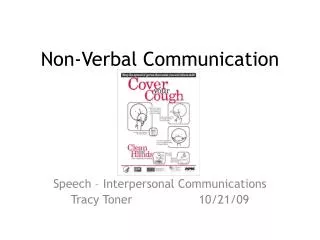
Non-Verbal Communication
Non-Verbal Communication. Speech – Interpersonal Communications Tracy Toner 10/21/09. Coughing – How do people react to the sound of a cough?.
547 views • 4 slides

NON-VERBAL COMMUNICATION
NON-VERBAL COMMUNICATION. It’s a Universal Code… though much is culture specific. What is Non-verbal Communication?. It’s all the non-verbal stimuli–both intentional and unintentional –that convey messages to each other. Examples….
696 views • 23 slides

Non-verbal Communication
Non-verbal Communication. American Sign Language (ASL), Picture Exchange Communication System (PECS), Interpretive Dance, and Non-Verbal Assessment Techniques . American sign language (ASL) (History).
4.11k views • 16 slides

NON-VERBAL COMMUNICATION. DISCUSSION SESSION #53 X420 Career Planning and Placement. Interpreting Non-Verbal Communications. 7% Verbal 38% Way words are said 55% Facial expressions. Human Communication. Sender: Thinking Encoding Transmitting Receiver: Perceiving Decoding
789 views • 13 slides

Non – Verbal Communication
Non – Verbal Communication. Definition. Bartol and Martin Define non- verbal communication as ” communication by means of elements and behavior that are not coded into words”.
1.36k views • 34 slides
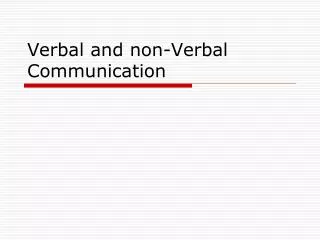
Verbal and non-Verbal Communication
Verbal and non-Verbal Communication. “Verbal Communication.”. We may often think that, having good communication skills is all about the ability to speak well….. Or all about “SPEAKING.”. We are right……. But only 50% right. Because….
1.74k views • 52 slides

Non-Verbal Communication . Business Communication By: Jabriel s.Jordan , John S. Pistulka , Spencer R. Mallonee, Spencer S. Kidder. Non-Verbal Communication . Why is it important? •First impression – 90% on nonverbal and 10% on verbal
1.87k views • 17 slides

VERBAL AND NON VERBAL COMMUNICATION
VERBAL AND NON VERBAL COMMUNICATION. 7 Cs. 1. Completeness 2. Conciseness 3. Consideration 4. Concreteness 5. Clarity 6. Courtesy 7. Correctness. 1.COMPLETENESS. Business message is complete when it contains all facts the reader or listener needs for the reaction you desire.
1.03k views • 38 slides

Verbal and Non-Verbal Communication
Verbal and Non-Verbal Communication. When you are finished the quiz, Open your textbooks and turn to page 187. Complete reading 12 Communication. When you are finished with the reading, create a T-chart which shows all the different ways we communicate verbally and non-verbally.
3.06k views • 11 slides

Non-Verbal Communication. Non-Verbal Communication and use of body language.
777 views • 33 slides

Non verbal communication
Non verbal communication. Eleni Fiaka. What is Non-Verbal Com?. It’s the way a person transfers messages to another person. This way of communication does not contains verbal language. But you can non verbally communicate with sounds(screams, tone of voice etc.)
608 views • 11 slides

Non-verbal communication
Non-verbal communication . “Actions speak louder than .. .”. What is non-verbal communication?. Nonverbal communication is behavior, other than spoken or written communication, that creates or represents meaning. Non verbal communication include s: F acial expression s B ody movements
351 views • 8 slides

NON-VERBAL COMMUNICATION. What Is Non-Verbal Communication?.
740 views • 33 slides

Non Verbal Communication
Non Verbal Communication. How necessary is it to use and interpret it?. Demosthenous Christiana. Non Verbal Communication. Non verbal Communication is the interaction between people without words but with gestures, facial expressions, eye contact etc.
1.51k views • 11 slides

Non-verbal Communication!
Non-verbal Communication!. Matsangides Maria . Department of Communication and Internet studies. Cyprus University of Technology. Communication:. Verbal communication: Is communication with words. Writing or speaking. For example: Face to face interaction. Using Telephone. E-mails.
612 views • 10 slides

Non-verbal communication. Metacommunication and Paralanguage. Non-verbal communication is anything other than words that communicates a message. The way we stand, walk, shrug our shoulders; the clothes we wear, the car we drive, or the office we occupy; all communicate ideas to others.
863 views • 39 slides

Non-Verbal Communication. Instructor Development. Does yours look like this?. Objectives. The Communication Process Characteristics Verbal & Non-Verbal Delivery Barriers Listening. Sender Sends The Message. Receiver Acknowledges Receipt. The Communication Process. Channel. Messages.
433 views • 16 slides

Verbal and Non Verbal Communication
Here is an outline of what is verbal and non-verbal communication, and how to improve it in most effective way. https://www.aksent.org.in/courses/communicative-english/
528 views • 10 slides

Non Verbal Communication. Nonverbal Communication. Is it possible to communicate without words?. Nonverbal Communication. Studies show that over half of your message is carried through nonverbal elements: Your appearance Your body language The tone and the pace of your voice.
1.52k views • 76 slides

Non Verbal Communication. What does the following sign mean to you?. In most of Europe and in the USA, the previous sign symbolises the word ‘ok’. However, in other cultures it means something different. For example, in Japan it can mean ‘money’.
396 views • 20 slides

Verbal and Non Verbal Communication.
1.68k views • 22 slides

IMAGES
VIDEO
COMMENTS
Nonverbal communication is made up primarily of movements and gestures. Identify the right combination of the two to amplify your message: Face your audience whenever possible. Maintain open body language. Move with purpose and for effect, not just for the sake of moving. Move into the group—do not "hug the wall.".
Nonverbal communication plays a critical role in public speaking for several reasons: 1. Conveys Emotion and Authenticity. Your facial expressions, gestures, and tone of voice allow you to express emotions authentically. When your nonverbal cues align with your message, it adds depth and authenticity to your talk.
Here are 10 of the most common forms of nonverbal communication: 1. Facial expressions. The look on an individual's face is often the first thing we see. A smile, frown, or grimace tells a lot about their mood and how the subsequent conversation will go. Expressions of happiness, sadness, anger and fear are universal emotions and key forms of ...
Non-verbal communication is an essential aspect of conveying your message during a presentation. It can amplify your message by helping you connect with your audience, emphasize key points, and maintain the audience's interest.Therefore, it is vital to develop your non-verbal communication skills to improve your presentation's impact.
Presentation Transcript. Nonverbal Communication We speak only with our mouths, but we communicate with our whole bodies. 80% of Communication is Nonverbal • Gestures • Body Position • Facial Expressions • Tone of Voice. Nonverbal Communication Communication without words; a process by which an individual stimulates meaning in the mind ...
Keeping your weight balanced on both feet. Matching your body language to your verbal messages can help convey greater meaning and clarify your intentions. Body movements and stance are important, but facial expressions, eye gaze, mouth movements, gestures, and personal space are also essential components. 7.
Non-verbal engagement is part of our daily lives, so pay attention to your movements when you interact with friends or co-workers. With practice, you will be able to naturally deliver a strong presentation when the time comes. Overall, things to consider are: Be conscious of your posture when standing and interacting with friends.
Non-verbal communication. The messages you communicate to others can also take place non-verbally—through your body language, eye contact, and overall demeanor. ... One of the best ways to improve communication is to work on creating concise and clear conversations, emails, and presentations that are error-free. Verbal communication tips.
Nonverbal communication is the other part of the communication equation, in which verbal and nonverbal communication are the two parts of the whole. Excellent communicators utilize both, and when presenting in virtual settings, it's not just the words you say, but the manner in which you say them — the nonverbal communication that ...
Professional speaker and presentation skills coach Gilda Bonanno explains how to master the elements of non-verbal communications (eye contact, voice, facia...
See why leading organizations rely on MasterClass for learning & development. There are many ways to facilitate effective communication. How you use your words, body language, tone of voice, and visual cues determine how you are understood. Verbal and nonverbal communication skills work in tandem to deliver an understandable message.
While these signals can be so subtle that we are not consciously aware of them, research has identified nine types of nonverbal communication. These nonverbal communication types are: Facial expressions. Gestures. Paralinguistics (such as loudness or tone of voice) Body language. Proxemics or personal space.
Communication is 55 percent non-verbal, 38 percent vocal (tone and inflection), and 7 percent words, according to Albert Mehrabian, a researcher who pioneered studies on body language . Up to 93 percent of communication, then, does not involve what you are actually saying. ... Design, and Presentation from the University of Colorado Boulder. ...
Presentation on theme: "NON-VERBAL COMMUNICATION"— Presentation transcript: 1 NON-VERBAL COMMUNICATION. 2 Nonverbal communication. Basically it is sending and receiving messages in a variety of ways without the use of verbal codes (words) 3 Non verbal communication. It includes Personal appearance Facial expression Movement Posture Gesture ...
Dec 15, 2018 • Download as PPTX, PDF •. 24 likes • 36,155 views. A. Aarti Choudhary. How to communicate your message. Presentations & Public Speaking. 1 of 52. Download now. Non verbal communication - Download as a PDF or view online for free.
Being mindful of our non-verbal communication can prevent the wrong or unintended message from inadvertently being passed on. Face-to-face communication allows for the most richness in non-verbal communication; this richness recedes from our interactions as we move from telephone conversations to e-mail, memos, bulletins and post-it notes.
Download the "Healthy Relationships and Communication Skills - 11th Grade" presentation for PowerPoint or Google Slides. High school students are approaching adulthood, and therefore, this template's design reflects the mature nature of their education. Customize the well-defined sections, integrate multimedia and interactive elements and ...
Non-verbal communication. Non-verbal communication. Metacommunication and Paralanguage. Non-verbal communication is anything other than words that communicates a message. The way we stand, walk, shrug our shoulders; the clothes we wear, the car we drive, or the office we occupy; all communicate ideas to others. 863 views • 39 slides
Elements of language such as voice, speed pitch, pause, volume, stress and tone comprise paralanguage. It is the non- verbal aspect of communication. It refers to the tone in which the message is spoken or written. 5, Chromatics: The use of colour to communicate is not new. Colour is used symbolically in different cultures.
Funny Illustration Education School Cream Teacher Middle School Doodle Language Arts Emotion Communication Editable in Canva. You can speak with your body and your actions too! Learn all about non-verbal language with this creative template for Google Slides & PPT.
Thus, this template is prepared for a elementary school lesson for you to teach about nonverbal communication. We have included cartoon-style illustrations that express different emotions, to emphasize how we communicate with just a facial expression. You have other resources such as charts, graphs or maps to make your lesson more productive.
Verbal And Non-Verbal Communication - Download as a PDF or view online for free. ... This is my presentation about verbal communications. I hope you can learn something in this presentation. This presentation us for educational purposes only. ANTON DULAY PPT VERBAL COMMUNICATIONS.pdf.
Non verbal ppt. Non verbal ppt DayanaVinnarasi ... TYPES OF NON-VERBAL COMMUNICATION Verbal communication is a form of communication in which you use words to interchange the information with other people. But, Nonverbal communication does not use words for communicating anything, but some other modes are used. ...
Nonverbal Communication • Reinforces, supports and enhances verbal messages • 55%-of messages are non-verbal • 38% are volume and tone • Leaving only 7% as verbal words. Examples of Non-Verbal • Eye Contact • Facial Expression • Gesture & Posture • Body Orientation • Distance • Appearance.